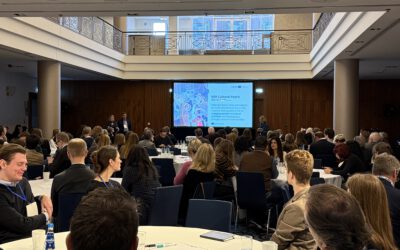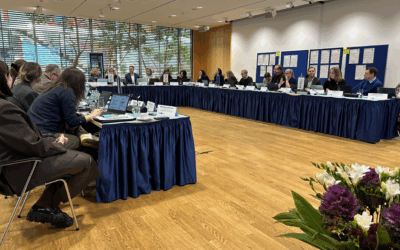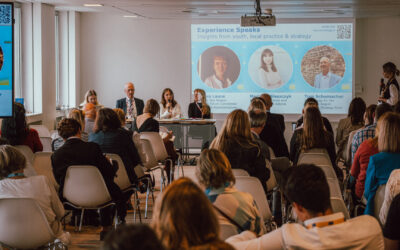Air pollution control of ships is receiving a lot of attention. While international organisations and governments have been actively fighting greenhouse gas emissions from industry and cars since the 1970s, ships were tackled only at the beginning of this millennium. Decreasing sulphur emissions has been in focus for the past years with a step-wise tightening of sulphur limits in fuelling ships. The Baltic Sea is a forerunner and test region for tighter limits. The cooperation project EnviSuM looks into the effects of the latest sulphur-limit tightening on human health, environment and the economy, namely the shipping sector.
She is one of the cleanest ships in the Baltic Sea region – Athena Seaways, the 200 m long ferry bringing trucks and passengers from Klaipeda to Karlshamn and back every day. Just a few years ago, her engine was upgraded by installing a scrubber. This device cleans the exhaust gases of the ship. Athena Seaways added the scrubber because a new regulation to limit sulphur emissions from ships by the International Maritime Organisation (IMO) entered into force in 2015. All ships sailing the Baltic Sea need to comply with this limit, and in 2020 stricter sulphur limits will be imposed worldwide.
Air emission control challenges shipping industry
The new restrictions in the Baltic Sea posed a challenge to many operators deploying their ships here. In 2012 several operators publicly called for a moratorium on the sulphur regulations as the scrubber technology was apparently not well developed and far too expensive. In 2015, some operators had to stop operating ships for several months before they could be retrofitted with scrubbers or replaced. Economic losses were incurred. On the other hand the regulation has activated development work among environmental technology innovations and novel solutions.
Learning from previous emission control
Nowadays, researchers from around the Baltic Sea are working on tools and recommendations for policy makers and authorities for developing future environmental regulations and on guidance for future investment decisions in the shipping sector. EUR 3.2 million are available in the EnviSum project to study technical efficiency and socio-economic impacts of clean shipping solutions by 2018. The project cooperates with one of the shipping operators that coped well with the heightened sulphur regulations in the Baltic Sea, Copenhagen-based DFDS.
Good practice in the shipping industry
The sulphur regulations had already been politically agreed on back in 2005. They were part of the IMO’s International Convention for the Prevention of Pollution from Ships (MARPOL). DFDS quickly became aware of the challenge and started preparing for it in 2007. The shipping company identified two options: The first one was to switch from fuelling their ships with crude oil to gas oil. Gas oil is around 1.5 times more expensive but contains significantly less sulphur. The second option was to upgrade their fleet with scrubbers, a rather new technology for ships. After three years of testing and improving the scrubber technology together with a manufacturer, DFDS made the decision to upgrade the fleet. The investment would be substantial: some EUR 100 million. Once the decision was made, DFDS started retrofitting their ships. And by the deadline in January 2015, DFDS had ten ships ready to sail under the new sulphur limitations.
EnviSuM supports the shipping industry
At that time, many other operators were not ready. For such operators, the EnviSuM project wants to provide guidance on future legislation concerning emissions from ships. For example researches will provide investigated results of abatement techniques and alternative fuels such as LNG to meet the emission reduction targets. Also an access to a maritime investment tool is given in order to help the maritime business to make cost-effective decisions. Poul Woodall, Environment and Sustainability Director at DFDS, says, “When we are facing bigger financial decisions such as in the case of the sulphur regulation, we use all the studies and forecasts that are available.”
EnviSuM helps shape future regulations
In addition, the project analyses different effects of sulphur regulation, namely by comparing air quality before and after its introduction, assessing health and ecosystem-level impacts and providing a cost-benefit analysis in different places in the Baltic Sea region. “Currently, Prime Minister’s Office in Finland is pondering the same questions that we are dealing with in our project, and our results will provide valuable information for policy makers and authorities”, says Minna Alhosalo, researcher at the Centre for Maritime Studies of the University of Turku, which is the lead partner of the project. “In addition to sharing information to the decision makers, we wish to present meaningful results to the whole maritime business”, she stresses.
Joint solutions for a common challenge
The EnviSuM project has an interdisciplinary partnership covering expertise on both the research and implementation levels in all the Baltic Sea countries. Minna stresses: “We need this expertise from around the Baltic Sea to do such comprehensive assessments and make meaningful recommendations.” Air pollution is a common challenge of countries in the region – and therefore requires joint solutions.
Survey ongoing: What are the costs/benefits of the Sulphur Emission Control Areas?
Currently, the University of Tallinn is running a survey about the economic impacts of Sulphur Emission Control Area (SECA) regulations on maritime market stakeholders. Maritime stakeholders from across the Baltic Sea region are encouraged to express their views. The comments will help policy makers get a better view of challenges that maritime stakeholder face.The final result will be consolidated together with other project activities into “Economic Guidelines for SECA” comprising of policy and business recommendations, and an “Investment Decision Tool” for all Maritime stakeholders.”

EnviSuM contributes to making the Baltic Sea region a model region for clean shipping. It is a designated flagship of the EU Strategy for the Baltic Sea Region.
Related links
» EnviSuM project
» University of Turku, Center for Maritime Studies
» DFDS
» MARPOL
» Survey “SECA Regulations Cost/Benefit Assessment for Maritime Stakeholders in the BSR”







